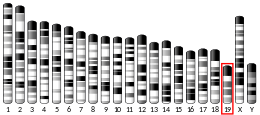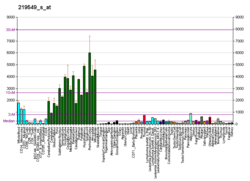RTN3
Reticulon-3 is a protein that in humans is encoded by the RTN3 gene.[5][6]
The reticulons are a group of highly conserved genes with preferential expression in neuroendocrine tissues (see, e.g., RTN1; MIM 600865).[supplied by OMIM][6]
References
- 1 2 3 GRCh38: Ensembl release 89: ENSG00000133318 - Ensembl, May 2017
- 1 2 3 GRCm38: Ensembl release 89: ENSMUSG00000024758 - Ensembl, May 2017
- ↑ "Human PubMed Reference:".
- ↑ "Mouse PubMed Reference:".
- ↑ Moreira EF, Jaworski CJ, Rodriguez IR (Jul 1999). "Cloning of a novel member of the reticulon gene family (RTN3): gene structure and chromosomal localization to 11q13". Genomics. 58 (1): 73–81. PMID 10331947. doi:10.1006/geno.1999.5807.
- 1 2 "Entrez Gene: RTN3 reticulon 3".
Further reading
- Maruyama K, Sugano S (1994). "Oligo-capping: a simple method to replace the cap structure of eukaryotic mRNAs with oligoribonucleotides". Gene. 138 (1–2): 171–4. PMID 8125298. doi:10.1016/0378-1119(94)90802-8.
- Suzuki Y, Yoshitomo-Nakagawa K, Maruyama K, et al. (1997). "Construction and characterization of a full length-enriched and a 5'-end-enriched cDNA library". Gene. 200 (1–2): 149–56. PMID 9373149. doi:10.1016/S0378-1119(97)00411-3.
- Qu X, Qi Y, Qi B (2002). "Generation of multiple mRNA transcripts from the novel human apoptosis-inducing gene hap by alternative polyadenylation utilization and the translational activation function of 3' untranslated region". Arch. Biochem. Biophys. 400 (2): 233–44. PMID 12054434. doi:10.1016/S0003-9861(02)00016-4.
- Strausberg RL, Feingold EA, Grouse LH, et al. (2003). "Generation and initial analysis of more than 15,000 full-length human and mouse cDNA sequences". Proc. Natl. Acad. Sci. U.S.A. 99 (26): 16899–903. PMC 139241
 . PMID 12477932. doi:10.1073/pnas.242603899.
. PMID 12477932. doi:10.1073/pnas.242603899. - Qi B, Qi Y, Watari A, et al. (2003). "Pro-apoptotic ASY/Nogo-B protein associates with ASYIP". J. Cell. Physiol. 196 (2): 312–8. PMID 12811824. doi:10.1002/jcp.10297.
- Oertle T, Klinger M, Stuermer CA, Schwab ME (2003). "A reticular rhapsody: phylogenic evolution and nomenclature of the RTN/Nogo gene family". FASEB J. 17 (10): 1238–47. PMID 12832288. doi:10.1096/fj.02-1166hyp.
- Di Sano F, Fazi B, Citro G, et al. (2003). "Glucosylceramide synthase and its functional interaction with RTN-1C regulate chemotherapeutic-induced apoptosis in neuroepithelioma cells". Cancer Res. 63 (14): 3860–5. PMID 12873973.
- Ota T, Suzuki Y, Nishikawa T, et al. (2004). "Complete sequencing and characterization of 21,243 full-length human cDNAs". Nat. Genet. 36 (1): 40–5. PMID 14702039. doi:10.1038/ng1285.
- Huang X, Yang H, Zhou Y, et al. (2004). "Overexpression of human reticulon 3 (hRTN3) in astrocytoma". Clin. Neuropathol. 23 (1): 1–7. PMID 14986927.
- Hu Y, Fang X, Dunham SM, et al. (2004). "90-kDa ribosomal S6 kinase is a direct target for the nuclear fibroblast growth factor receptor 1 (FGFR1): role in FGFR1 signaling". J. Biol. Chem. 279 (28): 29325–35. PMID 15117958. doi:10.1074/jbc.M311144200.
- He W, Lu Y, Qahwash I, et al. (2004). "Reticulon family members modulate BACE1 activity and amyloid-beta peptide generation". Nat. Med. 10 (9): 959–65. PMID 15286784. doi:10.1038/nm1088.
- Di Scala F, Dupuis L, Gaiddon C, et al. (2005). "Tissue specificity and regulation of the N-terminal diversity of reticulon 3". Biochem. J. 385 (Pt 1): 125–34. PMC 1134680
 . PMID 15350194. doi:10.1042/BJ20040458.
. PMID 15350194. doi:10.1042/BJ20040458. - Gerhard DS, Wagner L, Feingold EA, et al. (2004). "The Status, Quality, and Expansion of the NIH Full-Length cDNA Project: The Mammalian Gene Collection (MGC)". Genome Res. 14 (10B): 2121–7. PMC 528928
 . PMID 15489334. doi:10.1101/gr.2596504.
. PMID 15489334. doi:10.1101/gr.2596504. - Gan M, Qi Y, Wan Q, et al. (2005). "Mammalian apoptosis-inducing protein, HAP, induces bacterial cell death". Mol. Biol. Rep. 31 (3): 159–64. PMID 15560370. doi:10.1023/B:MOLE.0000043551.84883.c8.
- Kuang E, Wan Q, Li X, et al. (2005). "ER Ca2+ depletion triggers apoptotic signals for endoplasmic reticulum (ER) overload response induced by overexpressed reticulon 3 (RTN3/HAP)". J. Cell. Physiol. 204 (2): 549–59. PMID 15799019. doi:10.1002/jcp.20340.
- Cai Y, Saiyin H, Lin Q, et al. (2005). "Identification of a new RTN3 transcript, RTN3-A1, and its distribution in adult mouse brain". Brain Res. Mol. Brain Res. 138 (2): 236–43. PMID 15946766. doi:10.1016/j.molbrainres.2005.04.020.
- Wakana Y, Koyama S, Nakajima K, et al. (2005). "Reticulon 3 is involved in membrane trafficking between the endoplasmic reticulum and Golgi". Biochem. Biophys. Res. Commun. 334 (4): 1198–205. PMID 16054885. doi:10.1016/j.bbrc.2005.07.012.
- Rual JF, Venkatesan K, Hao T, et al. (2005). "Towards a proteome-scale map of the human protein-protein interaction network". Nature. 437 (7062): 1173–8. PMID 16189514. doi:10.1038/nature04209.
- Otsuki T, Ota T, Nishikawa T, et al. (2007). "Signal sequence and keyword trap in silico for selection of full-length human cDNAs encoding secretion or membrane proteins from oligo-capped cDNA libraries". DNA Res. 12 (2): 117–26. PMID 16303743. doi:10.1093/dnares/12.2.117.
- Heath JE, Siedlak SL, Zhu X, Lee HG, Thakur A, Yan R, Perry G, Smith MA, Castellani RJ (2010). "Widespread Distribution of Reticulon-3 in Various Neurodegenerative Diseases". Neuropathology. 30 (6): 574–9. PMC 2902651
 . PMID 20374499. doi:10.1111/j.1440-1789.2010.01107.x.
. PMID 20374499. doi:10.1111/j.1440-1789.2010.01107.x.
External links
- RTN3 human gene location in the UCSC Genome Browser.
- RTN3 human gene details in the UCSC Genome Browser.
This article is issued from
Wikipedia.
The text is licensed under Creative Commons - Attribution - Sharealike.
Additional terms may apply for the media files.




